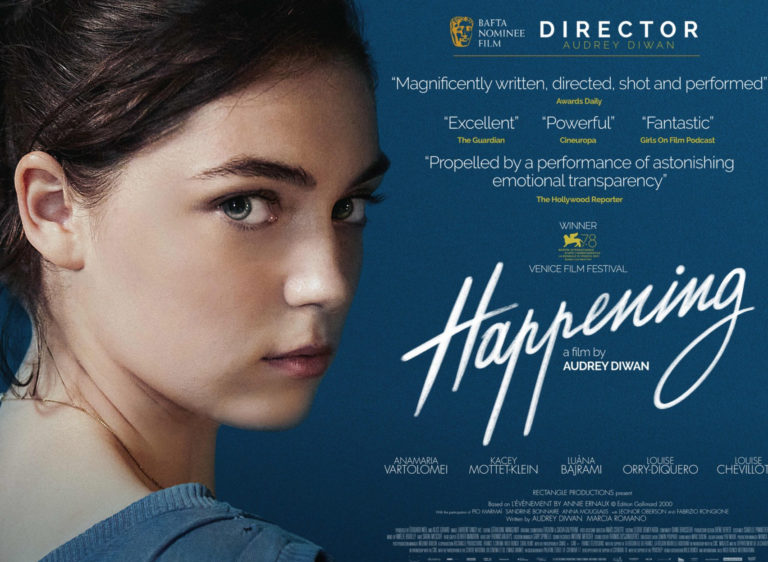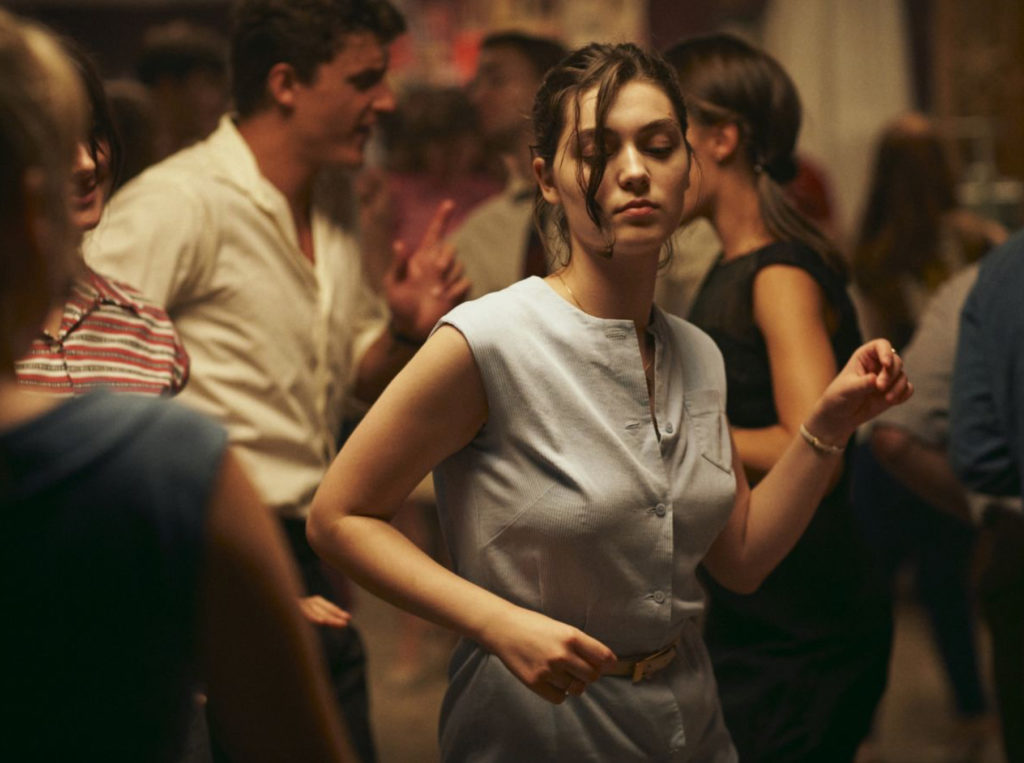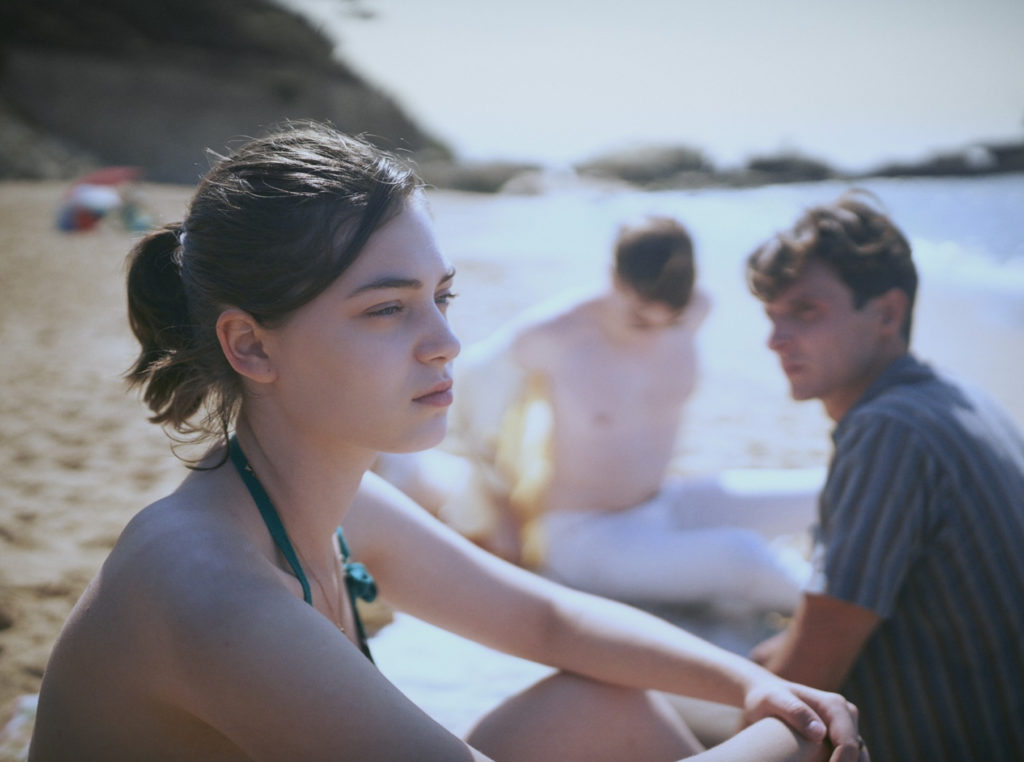
Synopsis : France, 1963. Anne is a bright young student with a promising future ahead of her. But when she falls pregnant, she sees the opportunity to finish her studies and escape the constraints of her social background disappearing. With her final exams fast approaching and her belly growing, Anne resolves to act, even if she has to confront shame and pain, even if she must risk prison to do so.

Exclusive Interview with Director Audrey Diwan
Q: This film is based on the experience of French author Annie Ernaux. What was it about her book that inspired you to make this film? Did you consult with Annie prior to making this?
AD: I’ve been reading Annie Ernaux’s books since a young age. I come from literature, but discovered “Happening” late in my life — after having an abortion myself.
I wanted to read up on the topic and was looking for a book that would help me think about abortion — what it meant then and now. I was struck by my lack of knowledge. I was raised with words like “legal abortion” but that meant nothing with regards to actual reality. I had the feeling while reading the book that it was some kind of intimate thriller. I couldn’t stop reading until the end. She’s fighting against her body and time.
I kept in mind her character, and that drove me to make the film because she just wanted to be free. She had sexual desire, intellectual desire; she was going from working class to being at a university with bourgeois students — and she wants to be a writer someday. So it’s how much you want to be free and your journey to achieve your freedom. Along the way, she has to have an illegal abortion.
Q: This film has a lot of scenes where the main character, Anne, expresses what she’s feeling inside. Obviously, it required a lot of facial expression by actress Anamaria Vartolomei. Talk about the casting process and why you chose Anamaria —who gave a standout performance?
AD: The first day I met Anamaria, I figured I’d work with her and give her the part. From the first time, she entered the room, she had this strong personality — you can see that in her face right away. I needed someone who could show a lot of emotions in a subtle way. I knew I would be shooting her face close up so that even her small smiles on the big screen would become huge. I needed someone who could give us a lot of things but not do too much, because too much would make the movie unwatchable.
Also, she has to have a strong relationship with words. That’s very important to me, because in France everybody knows Annie Ernaux, and that girl you see that’s a literature student could be Annie someday. I wanted someone who could understand the text and play with it, who would be my intellectual partner. I don’t do regular casting — it’s more like a long workshop.
Q: In this film, she’s not just dealing with physical nudity but also feels naked emotionally in going through her pains and struggles. How did you approach Anamaria to show a certain consistency of performance prior to shooting the film?
AD: As a director, I didn’t want to demand too much from my actors. I’m looking for partners, so we had to go into it hand in hand. I told her, “I’m going to set a horizon for each scene, and we are going to try to find out how to reach it together.” To me it’s about the meaning. And since the movie was postponed because of the lockdown, we had more time to work on it than we were supposed to.
We watched lots of different movies that I sent her, or she sent me, like “Rosetta” [Dardenne brothers], “Elephant” [Gus Van Sant], “Fish Tank” [Andrea Arnold], “Vagabond” [Agnès Varda], “Girl” [Lukas Dhont] — many movies that were composed of a kind of common language. We used small details from each movie to talk about Anne in the same way, until I could see that she knew who Anne was. And because I love to tell stories through the body, she had to know it in her body. When she arrived on set, I knew Anne — I knew the character — and she knew the character as well.
I don’t rehearse key scenes because if you want to do it properly you have to take risks. Sometimes the miracle happens, sometimes it doesn’t. You do it again and again, until you’ve outdone yourself — until you don’t look at yourself anymore.
She trusted me. As I said, it’s a bond between us. I think that’s why the movie works. It’s because we trusted each other.

Q: There’s a scene where one of Anne’s girlfriends demonstrates to her how to have sex. How did the American counter-culture — “sex, drugs and rock & roll” — affect France back then? It subtly in the background.
AD: I have to tell you about this sequence. If you talk about illegal abortion, you have also have to talk about sexual desire because the two are, of course, related. We are talking about characters who admit that they feel sexual desire — but we’re not talking about feelings, we’re talking about pleasure. We all know that it’s true that girls have both sexual desire and can have pleasure.
In the book, there’s not that much about sex. Annie wrote about sex, but in other books. These scenes come from my experience when I was younger. I was showing the same expressions as Anamaria does, like, “Okay.”
I worked with Annie Ernaux, but I also took from some of my own experiences and mixed them with hers. I wanted to involve myself in the story [as well]. Then Annie would read it and tell me if it was right as to who she was at the time, what was the mentality, and if the idea was right or not. She prevented me from doing anything that would be too anachronistic, or not true regarding the character.
Q: Even though this film tackles illegal abortion in the ’60s in France, some states in the U.S. today are prohibiting abortion by law. What is your opinion about the fact that we’re still dealing with this basic right for women?
AD: On my way to Venice, I was amazed when I heard about what happened in Texas. I would have never said that such a movie would still be accurate in America today. What struck me is that the story is the same thing every time. You look carefully at what happened in the simpler ’60s. With the law changed, I looked carefully at what’s going to happen to women in the United States today.
It’s always the same process. The main question we should be asking — how come this doesn’t change. I’ve been asking myself that. How come the narrative doesn’t change? The process is always the same, the risks are always the same, the answers are always the same. Job, death, survival — it’s always the same words and the same story. I think that’s stunning.
Q: I assume this film has been presented all over the world after it won the Venice Film Festival award. What kind of reaction did you get from the other countries? Some countries have a different reaction to abortion. What stood out for you?
AD: I love the way men have talked to me about the movie because a lot of them told me that they felt pain in their own belly. I wanted the movie to be a physical experience for an audience to ask themselves their own questions.
There were people who were against abortion who came to see the movie, and we managed to discuss it at the end. I think that’s when it becomes interesting; if it’s only those who are pro seeing it then we’re going nowhere. I want those against this to see it.
What’s important to me throughout is that we don’t accept the silence. We put it forward to see where it’s going. I think art and what’s intimate in life becomes political as long as you have an audience.

Q: In this film, one of the college students talked about getting pregnant in college during the ’60s in France and it was like the end of the world for her. How much did you talk to real people from the ’60s who had a similar experience — did you have a dialogue with them?
AD: The most valuable help I got was from Annie Ernaux because she not only told me her story, but she gave me a book of women’s testimonies — it’s really hard to get people talking about it. I met a woman who used to [perform] abortions, but it was a step-by-step conversation. Annie was a key person in the whole process of getting people talking about it.
It was so silent and taboo then that it was difficult to find out the best way to show those moments. We needed help from the medical university to show it correctly. There’s not much written about it.
Q: If you were in the same position as Anne was in the ’60s, what would you have done at that time?
AD: You’re the first person to ask me that question. That’s funny. If I didn’t feel ready, I would have done the same thing. I think that I relate, and can project myself into this young woman’s experience. She wants to be free, and be an artist one day. That’s pretty much the feelings that I had when I was younger. I wanted to be free to do whatever I want with my life. So yes, it’s the same.
Check out more of Nobuhiro’s articles.
Here’s the trailer of the film.

